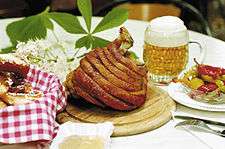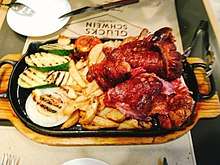Schweinshaxe
Schweinshaxe (German pronunciation: [ˈʃvaɪns.haksə]), in German cuisine, is a roasted ham hock (or “pork knuckle”).[1] The ham hock is the end of the pig's leg, just above the ankle and below the meaty ham portion. It is especially popular in Bavaria as Schweinshaxn [ˈʃvaɪns.haksn̩] or Sauhax(n) [ˈsaohaks(n̩)].[2] A variation of this dish is known in parts of Germany as Eisbein, in which the ham hock is pickled and usually slightly boiled.

Schweinshaxe is one of the formerly typical peasant foods, in which recipes were composed to make inexpensive and tough cuts of meat more palatable (see, for beef, the popular Sauerbraten). Such inexpensive cuts usually require long periods of preparation. The meat is sometimes marinated for days, and in the case of big cuts up to a week. The Schweinshaxe is then roasted at low temperatures, typically—depending on size—for two to three hours.
The most popular side dishes are potatoes and cabbage variations.

The Austrian version of this dish is called Stelze [ˈʃtɛl.tsə] or in dialect Stötzn/Stelzn ['ʃtœˑ.tsṇ]. It is usually marinated or pre-boiled in a caraway seed and garlic brine, roasted until the skin is crisp, and served with mustard, horseradish, and pickled chili peppers. The Bavarian version is classically served with potato dumplings and red cabbage,[3] or with sauerkraut and potatoes.
See also
- Eisbein
- List of ham dishes – also includes ham hock dishes
- List of German dishes
References
- Dawn Simonds, Best Food In Town: The Restaurant Lover's Guide to Comfort Food in the Midwest, Emmis Books, 2004, ISBN 1-57860-146-0
- Gerhard Schulze,Die Erlebnisgesellschaft: Kultursoziologie der Gegenwart, Campus Verlag, 2005, ISBN 3-593-37888-4
- Darwin Porter; Danforth Prince (2 December 2009). Frommer's Germany 2010. John Wiley & Sons. p. 308. ISBN 978-0-470-47073-2. Retrieved 11 December 2011.